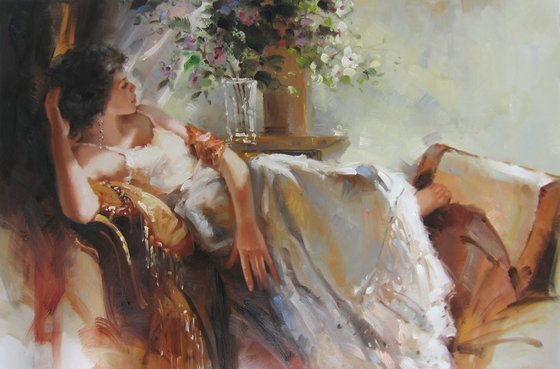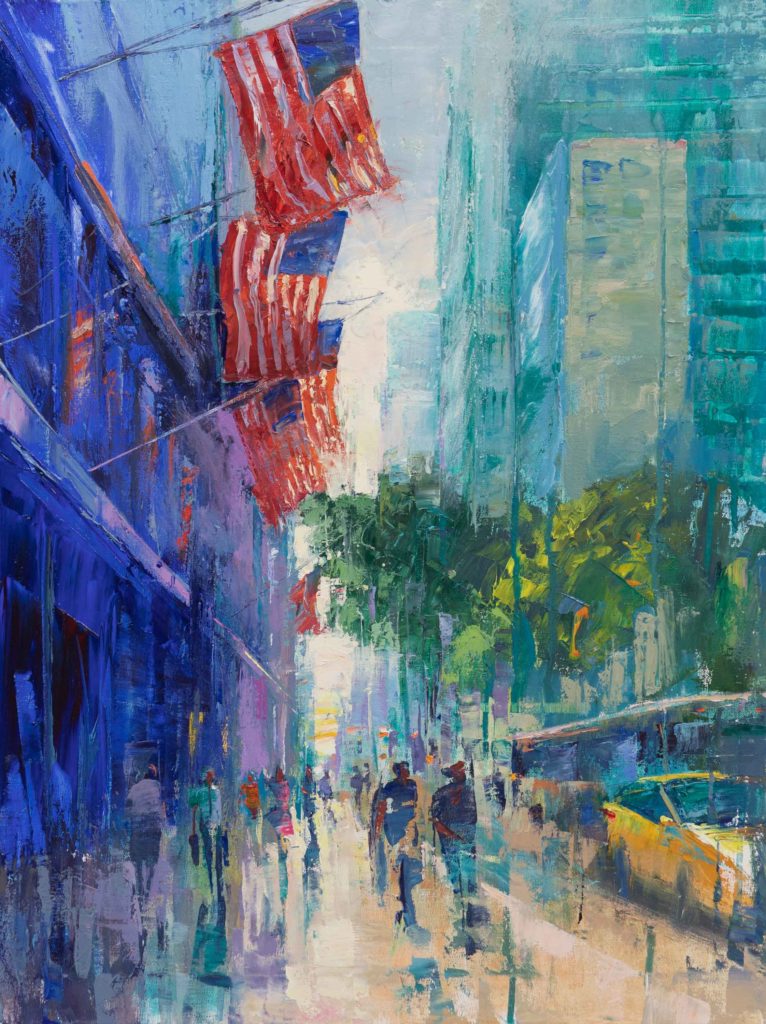Discover Timeless and Rare Oil Paintings for Sale Online
Discover Timeless and Rare Oil Paintings for Sale Online
Blog Article
Exploring Everything About Oil Paints: An Overview to Comprehending Their Charm and Value
Oil paints have captivated target markets for centuries, providing a look right into the artistic proficiency of various eras. Their abundant background is linked with cutting-edge techniques and profound psychological expression. Recognizing the materials and techniques behind these artworks can improve admiration. Additionally, the marketplace for oil paintings provides opportunities for financiers and enthusiasts alike. As one discovers this remarkable globe, the question emerges: what makes an oil painting genuinely important?
The Background of Oil Paint: A Trip With Time
Although oil paint has origins that go back to old times, it absolutely grew during the Renaissance, when musicians discovered its adaptability and rich color possibility. Early examples can be traced to the 7th century, with methods advancing significantly throughout societies. The medium ended up being prominent in Northern Europe in the 15th century, especially with the works of artists like Jan van Eyck, who pioneered its usage for in-depth realism and dynamic colors. This period marked a departure from tempera paints, enabling higher depth and appearance. As oil paint spread, it affected countless artists, causing work of arts by popular numbers such as Leonardo da Vinci and Rembrandt. The medium's tradition proceeds, shaping the art world well right into modern-day times.
Recognizing Oil Repaints: Materials and Techniques
As musicians explore the globe of oil paints, they encounter a varied array of materials and methods that define this tool. The key components of oil paint consist of pigments, which supply shade, and drying oils, such as linseed, that bind the pigments and help with application. Different ingredients can change the paint's appearance and drying out time, improving versatility. Strategies like glazing, where clear layers are constructed up, and impasto, which involves using thick paint, enable for various visual results. In addition, making use of brushes, palette blades, and even fingers can create one-of-a-kind textures and finishes. Recognizing these products and methods allows artists to fully express their creative thinking and accomplish the wanted influence in their art work.
The Duty of Color in Oil Paints
Shade plays a pivotal duty in oil paints, affecting both visual allure and emotional resonance. Understanding color theory fundamentals, consisting of the partnerships between colors, can enhance a musician's ability to share mood and ambience. Additionally, mastering color blending techniques enables higher deepness and richness in a paint's scheme.

Shade Concept Basics
Comprehending color concept is vital for artists working with oil paints, as it creates the foundation for developing visually engaging and harmonious make-ups. Color theory encompasses the research study of just how shades communicate, the color wheel, and the partnerships in between key, additional, and tertiary colors. Artists make use of complementary colors to enhance contrasts and develop focal factors, while similar shades promote unity and cohesiveness within an item. In addition, the ideas of amazing and warm colors affect the assumption of deepness and room in a paint. Realizing these principles allows musicians to adjust shade effectively, guiding the audience's eye and communicating their intended message. Mastery of shade concept ultimately enriches a musician's capacity to convey emotions and ideas with their job.
Psychological Effect of Color
The psychological impact of color in oil paintings plays a crucial duty in exactly how visitors regard and connect with art work. Shades stimulate particular sensations and moods, influencing the customer's emotion. Cozy shades like reds and oranges can produce a sense of heat and power, while awesome tones such as blues and greens usually evoke calmness or self-contemplation. Artists purposefully select shade combinations to enhance narrative aspects, directing the audience's psychological journey. The saturation and contrast of shades better magnify these impacts, attracting attention and developing focus. Eventually, the interplay of colors in oil paintings not just improves their visual allure yet also serves as a powerful tool for emotional expression, improving the customer's experience and interpretation.
Color Mixing Techniques
While numerous aspects of oil paint contribute to the total make-up, understanding color mixing strategies is crucial for attaining preferred impacts and depth. Shade blending can be come close to through numerous approaches, consisting of the additive and subtractive processes. Additive mixing entails integrating shades of light, while subtractive blending relies upon pigments, where shades blend to produce new shades. Musicians usually make use of a restricted palette to produce unified works, comprehending the partnerships between key, secondary, and tertiary shades. Strategies such as glazing and scumbling additionally improve depth and brightness. By skillfully mixing shades, an artist can evoke emotions, develop centerpieces, and attain a feeling of realistic look, inevitably boosting the paint's visual and psychological effect.
Famous Oil Painters and Their Iconic Works

Famed for their mastery of color and strategy, oil painters have actually developed several of the most celebrated art work in browse around this site history. Prominent artists like Vincent van Gogh mesmerized audiences with his emotive brushwork in "Starry Night," while Claude Monet's "Impression, Sunup" prepared for Impressionism. Leonardo da Vinci's "Mona Lisa" stays a long-lasting symbol of creative brilliant, showcasing his skill in recording human expression. Rembrandt's "The Evening Watch" illustrates his ingenious usage of light and darkness. Other noteworthy figures include Pablo Picasso, that reinvented modern-day art with his bold experimentation in works like "Les Demoiselles d'Avignon," and Georgia O'Keeffe, whose vibrant depictions of flowers and landscapes assisted define American innovation. Each artist's distinct design contributed considerably to the oil paint landscape.
Exactly how to Review the Top Quality of an Oil Painting
Examining the top quality of an oil painting includes a cautious analysis of workmanship methods, in addition to an evaluation of shade and make-up. Observing brushwork, layering, and the application of paint can disclose the musician's ability degree. In addition, the interaction of colors and the general plan of components add considerably to the paint's aesthetic value.
Evaluating Workmanship Methods
A meticulous assessment of craftsmanship strategies is necessary for establishing the high quality of an oil paint. Critics must first check out the application of paint; thick, textured brushstrokes might suggest a skilled hand, while overly consistent applications could show an absence of depth. oil paintings for sale. The layering method is likewise crucial; the existence of glazes and differed thickness can improve luminance and intricacy. Additionally, the high quality of the products made use of, such as the canvas and pigments, plays a substantial role in toughness and overall visual. Interest to detail in components like edges and shifts in between colors reflects the musician's dedication to their craft. Ultimately, these strategies add to the painting's emotional impact and market value, working as indications of the musician's skill and intent
Assessing Shade and Structure
While assessing the top quality of an oil painting, one must focus on the interaction of color and make-up, as these components are basic to the artwork's total effect. Color selections can develop and evoke feelings mood; for that reason, the musician's combination must be checked out for harmony and contrast. A healthy structure directs the audience's eye and develops a sense of unity. Musicians typically use strategies like the regulation of thirds or leading lines to improve aesthetic passion. In addition, the use of light and darkness can add deepness, boosting the three-dimensionality of the painting. Inevitably, a successful oil painting weds shade and structure, involving the customer and welcoming a much deeper appreciation of the artist's vision and method.
Taking care of and Preserving Oil Paintings
Proper care and conservation of oil paintings is crucial for maintaining their honesty and durability. To safeguard these art work, it is crucial to display them far from straight sunlight, which can trigger fading and discoloration. Maintaining a stable environment with controlled temperature and humidity further help in stopping damage. Cleaning up need to be done gently utilizing a soft, completely dry fabric, staying clear of any kind of rough chemicals that can damage the paint or varnish. Routine inspections for indications of damage, such as flaking or splitting, are a good idea. When keeping or transporting oil paintings, appropriate cushioning and framing are necessary to avoid physical damage. Eventually, diligent treatment contributes to click to read more the aesthetic allure and value of oil paintings in time.
The Market for Oil Paints: Investing and collecting
Understanding the market dynamics for oil paintings is crucial for investors and collection agencies alike. The worth of these artworks is affected by various aspects, including the musician's reputation, historical importance, and existing patterns. Enthusiasts commonly look for pieces that reverberate personally while taking into consideration potential admiration in worth. Auctions and galleries function as main locations for acquiring and marketing, with costs fluctuating based upon demand and rarity. Investing in oil paintings calls for study into the market, in addition to an understanding of credibility and provenance. Additionally, emerging musicians may supply opportunities for substantial returns, while established names can regulate high rates. Generally, a tactical technique to gathering can generate both aesthetic enjoyment and monetary rewards.

Regularly Asked Questions
What Are the Environmental Impacts of Oil Paint Products?
The ecological impacts of oil painting materials consist of the release of unpredictable natural substances (VOCs), damaging waste generation, and resource removal for pigments. These factors add to pollution and environmental destruction, increasing worries amongst eco mindful musicians and customers.
Just How Do Various Canvases Impact Oil Paint Results?
Different canvases affect oil painting results significantly. Structure, surface, and absorbency high quality can alter paint application, drying out times, and color vibrancy. Artists commonly pick details canvases to attain desired impacts and enhance their creative expression.
Can Oil Paintings Be Restored if Damaged?
If harmed, Oil paints can undoubtedly be recovered. Expert conservators utilize various methods to repair splits, tidy surface article areas, and address discoloration, making sure that the art work keeps its initial elegance and worth for future generations.
What Are the Indicators of an Initial Oil Paint?
The signs of an initial oil painting consist of noticeable brush strokes, appearance variations, and an uneven canvas weave (oil paintings for sale). In addition, credibility may be verified with provenance, trademarks, and the visibility of a varnish layer special to oil tools
How Has Technology Influenced Modern Oil Paint Techniques?
Innovation has actually substantially affected modern-day oil paint methods by introducing electronic tools for planning, improved products for structure and durability, and on-line platforms for sharing and offering art, therefore increasing artists' imaginative opportunities and audience get to. Oil painting has roots that date back to old times, it genuinely grew throughout the Renaissance, when artists discovered its flexibility and abundant shade possibility. The emotional impact of color in oil paintings plays an important function in exactly how visitors connect and perceive with artwork. While numerous elements of oil paint contribute to the total composition, mastering color blending techniques is necessary for accomplishing wanted impacts and deepness. Reviewing the top quality of an oil painting involves a cautious evaluation of workmanship strategies, as well as an evaluation of shade and make-up. While examining the quality of an oil painting, one should concentrate on the interaction of shade and composition, as these aspects are fundamental to the art work's total effect.
Report this page